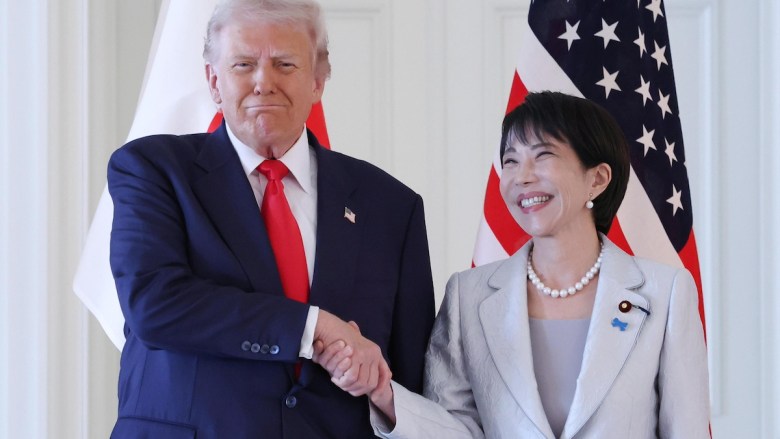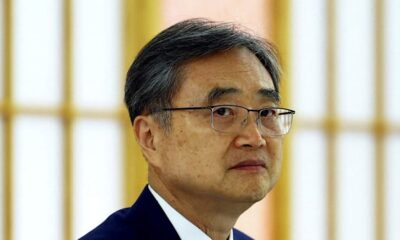Politics
Trump and Japan Forge New Economic Alliance for Investors

Donald Trump has proclaimed a “new golden age” in the relationship between the United States and Japan. This declaration signals a significant shift that is poised to impact global markets and investor strategies. The recent meeting between Trump and Japan’s new Prime Minister, Sanae Takaichi, highlighted a commitment to enhanced cooperation, particularly in areas such as defense, technology, and energy.
The partnership between Washington and Tokyo is not merely diplomatic; it is a strategic alignment focusing on national resilience and self-sufficiency. Both leaders are intent on an industrial strategy that fosters growth, which is likely to redefine investment priorities. For investors, this renewed alliance presents opportunities reminiscent of the economic boom seen in the 1980s.
Defense Spending and Economic Impact
Japan’s decision to increase its defense spending to 2% of GDP marks a decisive moment. This policy shift will channel substantial public investment into the manufacturing and technology sectors, particularly those related to military and cybersecurity capabilities. Global defense firms are already feeling the effects, and the benefits will extend to Japanese suppliers in components, robotics, and advanced engineering.
As American and Japanese contractors collaborate on next-generation systems and cybersecurity platforms, the alliance not only strengthens security ties but also opens new avenues for investment. Companies operating in defense, aerospace, and artificial intelligence sectors are likely to see immediate benefits from this momentum.
Another significant aspect of the US-Japan relationship is the focus on resources. A new agreement on rare earths and critical minerals is an important development as both nations aim to decrease reliance on Chinese supply chains for essential materials like lithium, nickel, and cobalt. These materials are crucial for electric vehicles and renewable energy systems. Japan’s pivotal role in global magnet production will be bolstered through joint ventures in extraction and processing, creating a robust investment narrative for those engaged in mining and energy transition infrastructure.
Investment Trends and Market Responses
Trade relations between the US and Japan are also evolving positively, with tariffs previously straining relations being eased. In 2025, Japanese investment in the US is projected to exceed US$60 billion, particularly in sectors such as semiconductors and battery manufacturing. These investments are expected to enhance industrial output, create jobs, and foster energy innovations, while simultaneously supporting the US dollar and reinforcing American leadership in advanced manufacturing.
Additionally, Japan’s domestic market is increasingly attractive. The Nikkei 225 index has surged to heights not seen in over 30 years, driven by structural reforms and improved corporate governance. A weak yen is boosting profits for exporters, while foreign capital is flowing into Tokyo, signaling a strategic re-evaluation of Japanese equities.
The partnership between the US and Japan is significant for investors seeking stability in an unpredictable global landscape. This alliance provides a consistent framework for trade, energy, and technological collaboration, promoting industrial growth and reliable capital allocation.
Moreover, Japan’s pension and insurance funds, managing over $5 trillion, are expanding their global investment strategies. This capital outflow is stabilizing markets in Europe and North America, further reinforcing the benefits of this partnership.
Energy cooperation is another defining feature of the alliance. The US continues to be a leading exporter of liquefied natural gas, while Japan advances in hydrogen and ammonia technology. Their joint focus on energy independence is creating investable themes that align with clean energy, infrastructure, and resource management.
The evolving dynamic between the US and Japan is of great significance for investors, as it reshapes growth prospects across various sectors. Defense and industrial stocks in the US, along with technology and infrastructure firms in Japan, are at the forefront of this transformation.
Trump’s strategy emphasizes rewarding nations that invest in America and share defense responsibilities. With Japan responding decisively, its status as a key economic ally in Asia is solidified. This trust reduces geopolitical risks and enhances confidence in long-term capital commitments.
As other nations, including South Korea and Taiwan, deepen their cooperation in technology and defense, the shift in global manufacturing is evident. This emerging economic structure is built on shared interests and mutual profitability, signaling the advent of a new era in international trade.
In summary, the alliance between the US and Japan is poised to create a powerful investment framework based on stability, innovation, and industrial resurgence. With both nations at the helm of shaping future global growth, investors can anticipate new opportunities and a more predictable investment landscape in the years to come.
-

 Lifestyle5 months ago
Lifestyle5 months agoHumanism Camp Engages 250 Youths in Summer Fest 2025
-

 Business5 months ago
Business5 months agoKenvue Dismisses CEO Thibaut Mongon as Strategic Review Advances
-

 Sports5 months ago
Sports5 months agoDe Minaur Triumphs at Washington Open After Thrilling Comeback
-

 Sports5 months ago
Sports5 months agoTupou and Daugunu Join First Nations Squad for Lions Clash
-

 Top Stories5 months ago
Top Stories5 months agoColombian Senator Miguel Uribe Shows Signs of Recovery After Attack
-

 World3 months ago
World3 months agoSouth Korea’s Foreign Minister Cho Hyun to Visit China This Week
-

 World5 months ago
World5 months agoASEAN Gears Up for Historic Joint Meeting of Foreign and Economic Ministers
-

 Health5 months ago
Health5 months agoNew Study Challenges Assumptions About Aging and Inflammation
-

 Business5 months ago
Business5 months agoOil Prices Surge Following New EU Sanctions on Russia
-

 Entertainment5 months ago
Entertainment5 months agoDetaşe-Sabah Violin Ensemble Captivates at Gabala Music Festival
-

 Business3 months ago
Business3 months agoStarling Bank Plans Secondary Share Sale, Targeting $5.4 Billion Valuation
-

 Entertainment5 months ago
Entertainment5 months agoBaku Metro Extends Hours for Justin Timberlake Concert









